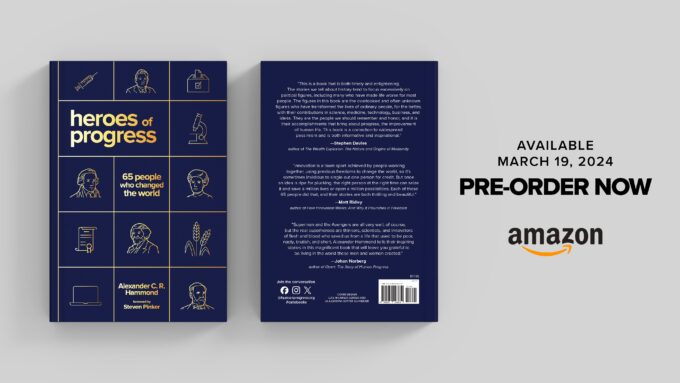Dystopian visions of the future are as old as humanity itself. As I noted in a previous column, one of our most consistent concerns is the interplay between population growth and the supposed finality of natural resources. According to conventional wisdom, a rising population – there will be 10 billion of us by 2050 – must result in poverty and famine.
Yet, human beings, unlike other animals, can innovate their way out of scarcity by increasing the supply of natural resources or developing substitutes for overused resources. Human ingenuity, in other words, is “the ultimate resource” that makes all other resources more plentiful. Now is a good time to look at one concrete example: the water supply.
A brief search on Amazon.com yields a veritable smorgasbord of books and videos concerning the supposed impending shortage of the vital liquid. The “problem” is not new. As an undergraduate student of international relations, I was taught that water was “liquid gold” and future wars would be fought over it.
Twenty years later, the BBC has published an article entitled, “Is this the real liquid gold? Why tapping into Earth’s most precious resource could be the next big thing.” According to the BBC, “The problem isn’t that there’s too little water on the planet, it’s that there’s not enough clean fresh water to go around. Only 1 per cent is consumable by humans, according to the US Environmental Protection Agency. Desalinisation plants, which convert salt water … to clean water, are still expensive to build.” Well, that’s rapidly changing.
Before proceeding: a bit of physics and chemistry. Reverse osmosis is a water purification technology that uses a semipermeable membrane to remove larger particles from drinking water. During the process:
…water from a pressurized saline solution is separated from the dissolved salts. The permeate (ie, the liquid flowing through the membrane) is encouraged to flow through the membrane by the pressure differential created between the pressurized feed water and the product water, which is at near-atmospheric pressure. The remaining feed water continues through the pressurized side of the reactor as brine. No heating or phase change takes place. The major energy requirement is for the initial pressurization of the feed water.
Put differently, the supply of fresh water depends on the availability of cheap and environmentally-friendly energy.
When reverse osmosis desalination started being commercialised in the late 1970s, scientists faced the problem of low energy recovery systems and inefficient membranes. The energy consumption to generate the pressure needed to overcome osmotic pressure was as high as 10 kilowatt hours of electricity per cubic metre of fresh water (10kWhr/m3). The average energy consumption rate of today’s desalination plants is 4.5kWh/m3.
Trouble is that some sources of energy are more preferable than others. One of the main problems concerning desalination is the emission of CO2. That is especially true of the large desalination plants in the Middle East. In Saudi Arabia, for example, it is estimated that nearly 300 thousand barrels of oil are used daily to generate electricity needed to power desalination plants. But, what if you could replace burning of fossil fuels with solar power?
According to a 2011 study in Renewable and Sustainable Energy Reviews, the first solar-powered reverse osmosis desalination test took place in Saudi Arabia in 1981. The results were not encouraging. The Saudis were only able to produce 3.2 cubic meters of desalinated water per day and the energy needed was enormous – between 16 and 19kWh/m3.
But things have changed. A 2016 Renewable Energy Market Analysis: The GCC Region notes that the cost of solar energy has decreased so much that it is competitive even in the oil-rich Middle East. As an example, the Mohammed bin Rashid Al Maktoum Solar Park in Dubai produces solar energy at US 5.85 cents per kWh.
The same report states that the combination of solar power and reverse osmosis can be competitive with fossil fuel-based desalination at oil prices as low as US$20 per barrel. Estimates also indicate that using off-grid systems, such as solar-diesel hybrids can get prices as low as US$2 per m3. In contrast, systems powered entirely by diesel cost, on average, US$2.2 per m3.
Today, solar-powered reverse osmosis plants account for only 0.8 per cent of global desalination capacity. If solar panels satisfied 44 per cent of the annual energy load of each reverse osmosis desalination plant, however, solar power could reduce the use of diesel fuel by 2 billion barrels annually. It could also reduce CO2 emissions by 832 million tons per year.
Happily, the world’s largest solar-powered desalination plant is under construction in the city of Al Khafji, Saudi Arabia. This project, which was launched by King Abdulaziz City for Science and Technology in cooperation with IBM, is expected to be fully functional later this year. The plant will cost US$130 million and be capable of producing 60,000m3 per day. As such, it will pay for itself in less than six years.
Solar power will not work as efficiently everywhere on Earth. Luckily, places that need fresh water most are also places with abundant sunshine. Humanity will face many challenges in the future, and solar-powered desalination is a testament to human ability to solve one of them.
Not bad, ape descendants! Turns out that our Latin moniker Homo Sapiens (wise man) may be well earned after all.
This first appeared in CapX.



